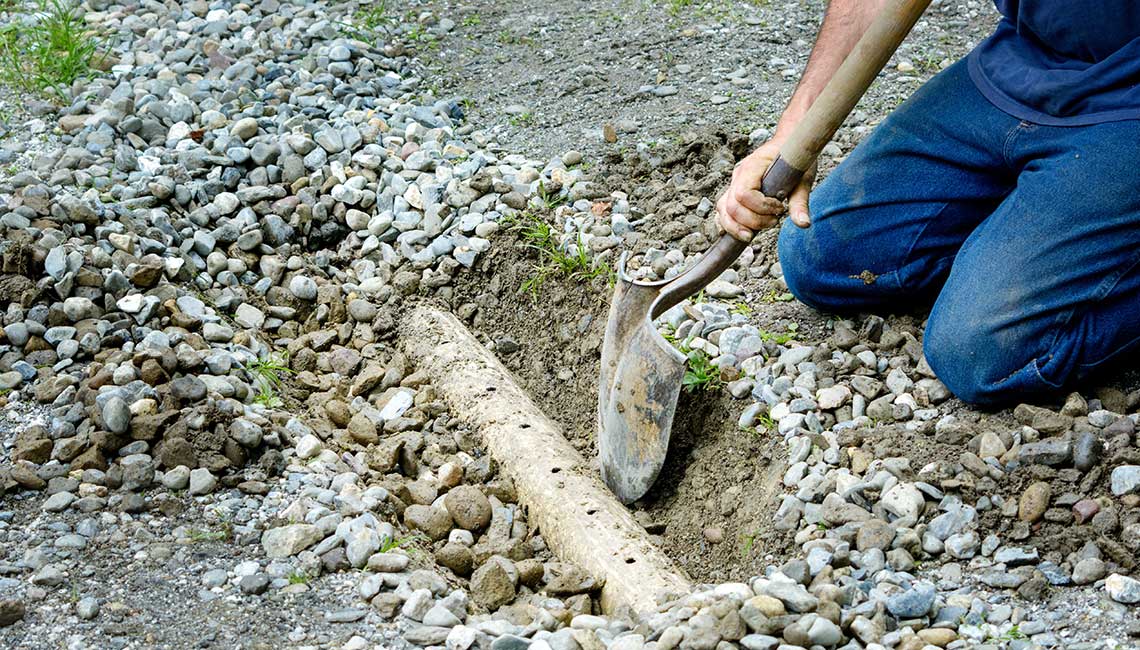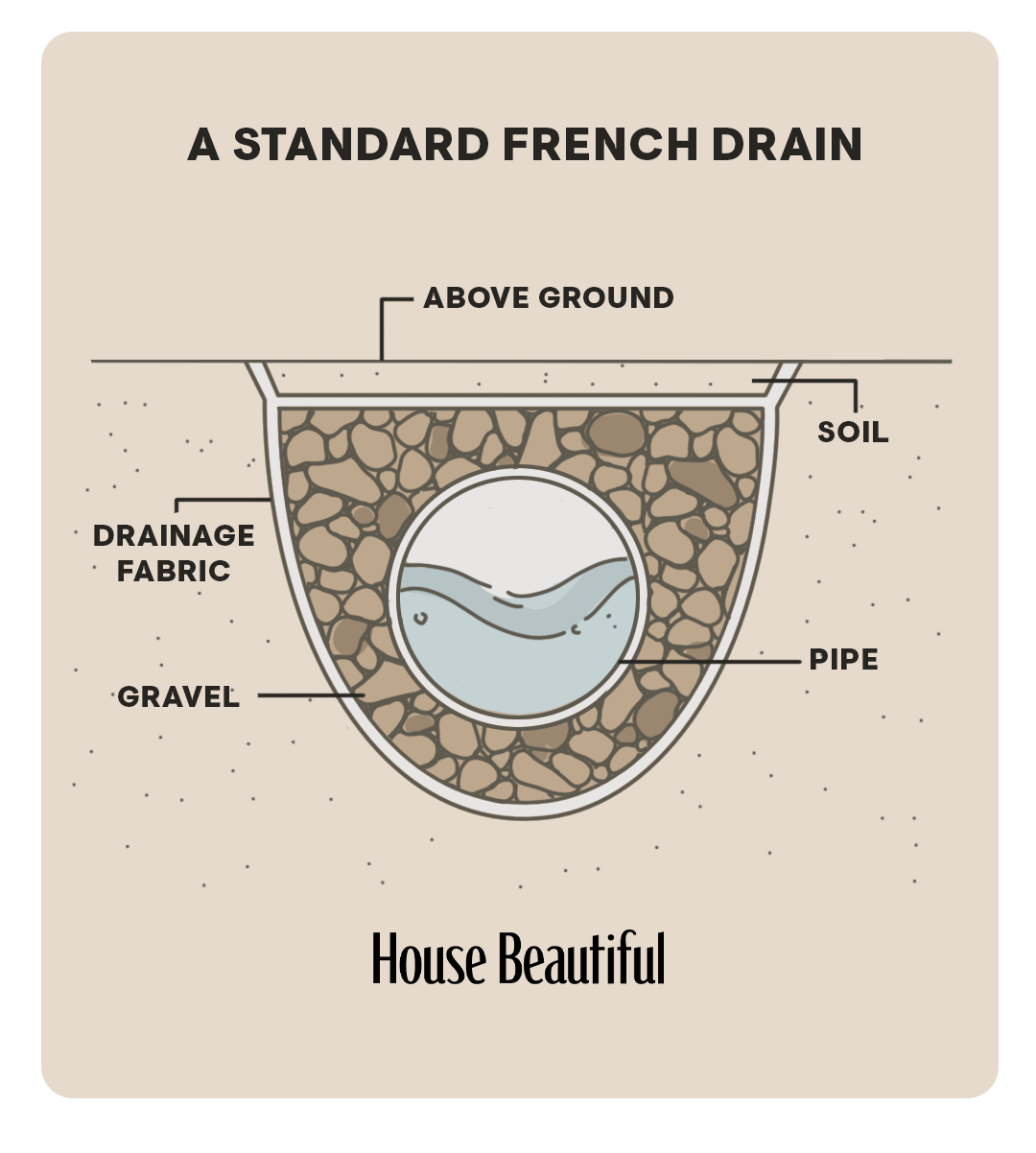Exactly How a French Drain Can Aid Prevent Water Damages in Your Basement
A French drainpipe may be the solution you require if you're dealing with a moist cellar. This system effectively redirects water far from your foundation, assisting to avoid expensive damage. Understanding exactly how it works and acknowledging the signs that you need one can make a significant distinction in your home's safety and security and comfort. However before you make a decision, it's vital to check out the advantages and installation procedure to see if it's the right fit for your scenario
What Is a French Drain?
A French drain is a basic yet effective service for handling excess water around your home. It's designed to redirect water far from at risk areas, like your basement or foundation. Normally, it consists of a trench loaded with gravel and a perforated pipeline that accumulates and networks water. When rain or groundwater accumulates, the drain effectively overviews it away, stopping possible damage.You might notice French drains mounted along property lines, driveways, or perhaps near your home's foundation. They can be found in different dimensions and setups, making them adaptable to different landscapes and drainage needs. Installing a French drainpipe can aid you avoid expensive repair services and secure your home's architectural stability. If you've been dealing with water pooling or soggy locations in your backyard, a French drainpipe might be the service you need. It's a proactive measure to assure your residential or commercial property remains secure and completely dry from water-related problems.
How Does a French Drainpipe Job?
When water builds up around your residential or commercial property, a French drain kicks into activity to redirect it effectively. This system contains a trench loaded with gravel and a perforated pipeline at the bottom. The pipe accumulates excess water from the soil and networks it away from your foundation.As rain or groundwater seeps into the crushed rock, it streams through the openings and into the pipeline. Gravity does the job, pulling the water far from your basement and routing it to a designated water drainage area, like a tornado drain or completely dry well.You can mount a French drainpipe either inside or outside your home. If you choose an outside setup, it'll stop water from pooling near your foundation. An indoor drain will certainly capture water that permeates through your basement wall surfaces. This reliable design maintains your space completely dry, permitting you to enjoy your home without the concern of water damages.
Advantages of Installing a French Drainpipe
Mounting a French drainpipe can significantly enhance your home's strength against water damages. You'll appreciate effective water diversion, which assists minimize mold and mildew growth and protect your building. Plus, a well-maintained drain system can also improve your property's value.
Reliable Water Diversion

Lowered Mold Development
Since dampness produces an ideal environment for mold and mildew to thrive, lowering water accumulation around your home is critical for preserving a healthy and balanced home. Mounting a French drain successfully networks excess water away from your structure, maintaining your basement dry. This positive measure substantially lowers moisture degrees, making it harder for mold spores to clear up and grow.With much less wetness, you'll find it simpler to take a breath and enjoy a clean, risk-free setting. Plus, you'll minimize the threat of health and wellness concerns linked with mold exposure, such as allergies and respiratory system troubles. By buying a French drain, you're taking an essential step toward a mold-free basement, making sure that your home continues to be a comfy area for you and your family.
Enhanced Building Worth
A French drainpipe can greatly boost your building's value, making it a smart investment for homeowners. When potential buyers see a well-maintained basement free from water damages, they're more probable to be pleased. This function not just enhances your home's allure yet additionally signifies that you have actually taken positive steps to safeguard it. By decreasing the threat of water-related issues, your residential property ends up being a lot more appealing in a competitive market, typically causing higher offers. In addition, the long-lasting cost savings on repairs and upkeep can equate right into boosted equity. Setting up a French drain reveals you respect your home's integrity, comforting purchasers that they're making a sound purchase. Inevitably, it's an important addition that settles in more means than one.
Signs You Required a French Drain
It's a clear sign that you may require a French drainpipe if you see relentless water accumulation in your lawn or basement. Furthermore, a have a peek at this website stuffy smell can indicate trapped moisture, which can result in bigger issues. Addressing these signs early can help avoid severe water damage to your home.
Consistent Water Build-up
When you observe persistent water build-up around your home, it's a clear indication that a French drain could be required. Water pooling near your foundation can lead to substantial damages gradually, including structural problems and mold development. You should take note of locations where water appears to collect after hefty rainfalls or snowmelt. If your lawn stays soaked for days, it's time to do something about it. In addition, seek indications of erosion or sloppy patches, as these can indicate inadequate drain. Mounting a French drain helps reroute water away from your home, protecting your structure and minimizing the danger of water damages. Do not await larger issues to arise-- addressing water buildup now can conserve you expensive repairs later on.
Musty Odor Existence
Consistent water build-up often causes more than just visible pooling; it can produce an atmosphere ripe for mildewy odors. If you observe a wet, stagnant scent in your basement, it's an indicator that dampness is sticking around, typically as a result of bad drainage. This smell typically indicates mold or mold development, which can pose wellness risks and harm your personal belongings. You could locate that the smell worsens during humid weather condition or after heavy rains. It's time to examine a French drainpipe if you're fighting consistent mildewy smells. This system reroutes water far from your foundation, lowering moisture levels and combating those unpleasant scents. Don't overlook this warning indicator; resolving it quickly can conserve you from more comprehensive water damage down the line.
The Setup Refine of a French Drainpipe
Mounting a French drain can be a straightforward process that significantly improves your home's water damages prevention. First, assess the location where you intend to install the drain, ensuring it slopes away from your structure. Next, note the trench's course, which should have to do with 6-8 inches broad and 18-24 inches deep.Excavate the trench, getting rid of soil as required. Portland French Drain. As soon as you've obtained your trench, set landscape material to avoid dirt from obstructing the drainpipe. Add a layer of crushed rock at the bottom. Place a perforated pipeline in addition to the crushed rock, guaranteeing the holes encounter downward for efficient drainage.Cover the pipeline with more crushed rock, leaving about 3 inches of space at the top. Fold up the landscape fabric over the crushed rock to shield it. Ultimately, fill in the trench with dirt, compacting it as you go. You have actually now established up a reliable system to redirect water far from your cellar!
Upkeep Tips for Your French Drainpipe
A French drain is developed to efficiently manage water flow, normal upkeep is vital to verify its ongoing performance. Beginning by inspecting the drain and its environments for debris or blockages. Clear any fallen leaves, dirt, or debris that may accumulate, specifically after heavy rains.Next, examine the outlet for correct drain. It should guide water far from your foundation-- if it doesn't, you may require to change its placement. Furthermore, validate that the crushed rock bordering the drain is undamaged and hasn't worked out with time; this helps maintain correct water flow.Consider scheduling a yearly specialist evaluation to capture any kind of issues early. If you observe any type of indications of water damages or merging, resolve them important source quickly to avoid larger issues in the future. With a little attention, your French drainpipe can efficiently secure your cellar for several years to come.
Expense Considerations and Long-Term Cost Savings
When taking into consideration a French drainpipe, it's crucial to weigh both the initial investment and the long-term financial savings it can provide. While the upfront cost might appear substantial, think of it as an investment in your house's future. Installing a French drainpipe commonly varies from $1,500 to $5,500, depending upon your basement's size and the intricacy of the installation.However, this expense can save you thousands in possible water damages, mold removal, and foundation repair work. By avoiding water accumulation, you're additionally safeguarding your home's value and staying clear of expensive insurance coverage claims. In addition, a dry cellar can lower your power costs, as moisture can bring about raised heating & cooling costs. Ultimately, the tranquility of mind that comes with recognizing your home is protected from water damages is priceless. Take into consideration these aspects thoroughly to make an educated decision that benefits you in the lengthy run.

Regularly Asked Questions
Can a French Drain Be Mounted in Any Kind Of Type of Soil?
Yes, a French drainpipe can be installed in different dirt kinds, consisting of clay, sand, and loam. Nevertheless, appropriate installment and water drainage planning are important to ensure it operates properly in your specific soil conditions.
The length of time Does a French Drainpipe Last Before Requiring Replacement?
A French drainpipe generally lasts around 30 to 40 years with correct setup and maintenance. Nonetheless, aspects like dirt type and water circulation can affect its life-span, so keep an eye on its efficiency.
Can French Drains Assistance With Yard Drain Issues?
Yes, French drains pipes can effectively these details attend to backyard drainage problems. They route excess water far from issue locations, preventing pooling and guaranteeing your landscape remains healthy. Installing one can substantially improve your lawn's general water drainage efficiency.
Will a French Drain Impact My Landscape Design or Yard?
A French drain can impact your landscaping or yard, specifically if it's mounted improperly. You'll wish to make sure it's positioned purposefully to minimize disturbance, protecting your plants and general visual while boosting drainage.
Are There Alternatives to French Drains for Basement Water Issues?
Yes, there are options to French drains for cellar water problems. You could consider sump pumps, waterproof finishings, or grading your lawn to redirect water away. Each choice has its benefits, so assess what fits your requirements best. When rainwater or groundwater builds up, the drain efficiently overviews it away, preventing potential damage.You could see French drains pipes mounted along home lines, driveways, or even near your home's foundation. Gravity does the work, drawing the water away from your cellar and routing it to a marked water drainage location, like a storm drain or dry well.You can mount a French drainpipe either inside or outside your home. By successfully transporting water away from your residential property, a French drainpipe can significantly decrease the risk of water damages. Mounting a French drain helps reroute water away from your home, securing your foundation and decreasing the risk of water damages. Setting up a French drain can be a straightforward procedure that substantially improves your home's water damage avoidance.